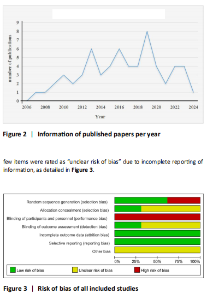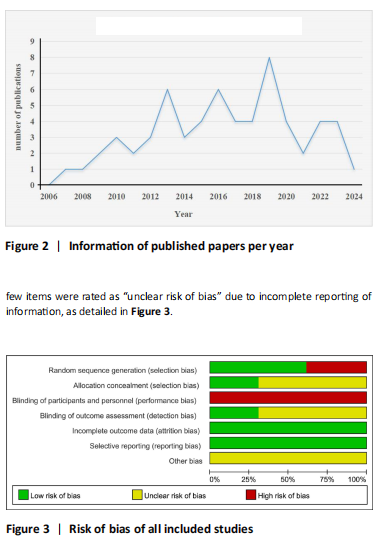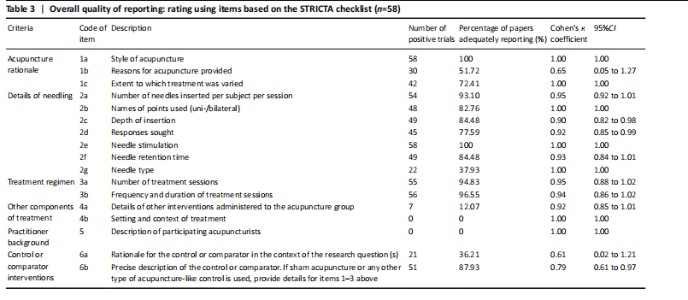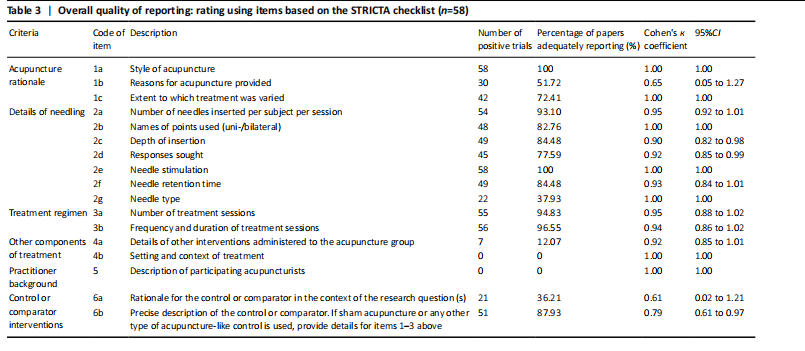Chinese Journal of Tissue Engineering Research ›› 2025, Vol. 29 ›› Issue (30): 6566-6573.doi: 10.12307/2025.930
Previous Articles Next Articles
Reporting quality of randomized controlled trials on acupuncture and manipulation for greater occipital neuralgia evaluated using the CONSORT statement and STRICTA checklist
Liu Liguo1, Qiu Mingwang2, Huang Yanling2, Fan Zhiyong2, Wu Shan2, Guo Rusong2
- 1Second Clinical College of Guangzhou University of Chinese Medicine, Guangzhou 510405, Guangdong Province, China; 2Second Affiliated Hospital of Guangzhou University of Chinese Medicine, Guangzhou 510120, Guangdong Province, China
-
Received:2024-10-11Accepted:2024-10-23Online:2025-10-28Published:2025-03-29 -
Contact:Wu Shan, MD, Chief physician, Doctoral supervisor, Second Affiliated Hospital of Guangzhou University of Chinese Medicine, Guangzhou 510120, Guangdong Province, China Corresponding author: Guo Rusong, MS, Associate chief physician, Master’s supervisor, Second Affiliated Hospital of Guangzhou University of Chinese Medicine, Guangzhou 510120, Guangdong Province, China -
About author:Liu Liguo, Doctoral candidate, Second Clinical College of Guangzhou University of Chinese Medicine, Guangzhou 510405, Guangdong Province, China -
Supported by:National Natural Science Foundation of China, No. 81874511 (to WS); Guangdong Province Famous Chinese Medicine Inheritance Studio Construction Project, No. 102018007 (to FZY); Guangdong Province Fourth Batch of Famous Chinese Medicine Apprenticeship Project, No. 102018105 (to WS)
CLC Number:
Cite this article
Liu Liguo, Qiu Mingwang, Huang Yanling, Fan Zhiyong, Wu Shan, Guo Rusong. Reporting quality of randomized controlled trials on acupuncture and manipulation for greater occipital neuralgia evaluated using the CONSORT statement and STRICTA checklist[J]. Chinese Journal of Tissue Engineering Research, 2025, 29(30): 6566-6573.
share this article
Add to citation manager EndNote|Reference Manager|ProCite|BibTeX|RefWorks
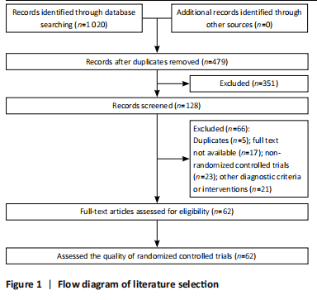
Search results The initial search yielded 1 020 studies, which were reduced to 479 after removing duplicates. Through preliminary screening of titles and abstracts, 128 relevant studies were selected. After further full-text screening, a total of 62 studies were ultimately included[15-76]. Among them, 60 reports were written in Chinese, and two reports were written in English; however, all reports were published by Chinese researchers. The flow diagram of literature selection is shown in Figure 1. Information on published papers per year All the studies were published between 2007 and 2024, with an overall increasing trend in the number of publications. The peak was reached in 2019, with a total of 8 articles published. Details can be found in Figure 2. Quality of the studies Risk of bias The quality of the included literature was evaluated using the Cochrane Collaboration’s tool for assessing the risk of bias. The results indicated that most items were classified as “low risk of bias,” while the proportion of “high risk of bias” items was the lowest, primarily concentrated in the “Random sequence generation” and “Binding of participants and personnel” sections. Specifically, some studies mentioned randomization but did not describe the method used to generate the randomization results, thus being rated as “high risk of bias.” Moreover, although some studies reported the implementation of single blinding in their respective articles, blinding of participants and personnel was deemed impractical considering the designs of the included studies, thereby increasing the potential for performance bias. Low-quality RCTs will produce evidence and results that lack credibility and may even mislead readers and affect the implementation of clinical decision-making. A"
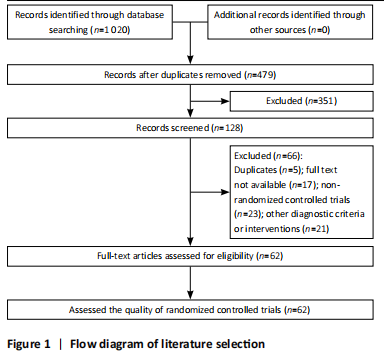
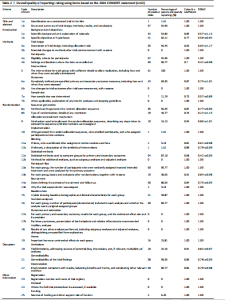
CONSORT statement We conducted a quality report on the 62 included studies according to the CONSORT statement (Table 2). Among the 37 items encompassed within the eight criteria, 15 items had a reporting rate exceeding 50%, with 1 item achieving a 100% reporting rate. Meanwhile, nine items had a reporting rate of 0%, but it is important to note that most of these items are only required to be reported when necessary and are not mandatory. Therefore, their low reporting rates do not necessarily reflect the quality of reporting. Additionally, items with a reporting rate below 50% were mainly concentrated in the following aspects: “Identification as a randomized trial in the title” (1/62, 1.61%), “How sample size was determined” (7/62, 11.29%), “Implementation” (1/62, 1.61%), “Blinding” (1/62, 1.61%) (2/62, 3.23%), “Losses and exclusions after randomization” (19/62, 30.65%), “A table showing baseline data” (21/62, 33.87%), “Reports of Harms” (16/62, 25.81%), “Reports of limitations” (20/62, 32.26%), and “Reports of funding” (4/62, 6.45%). It remains unclear what factors may reduce the credibility of the research results or even lead to misleading conclusions. In the evaluation of the 37 items by two reviewers, 31 items had kappa values greater than 0.8, and the kappa values of the remaining six items were all within the range of 0.6 to 0.8, indicating good overall consistency. STRICTA checklist Using the STRICTA checklist, a quality assessment was conducted on the 58 included studies related to acupuncture, as shown in Table 3. Among the 17 items encompassed by the 6 Criteria, 12 items had a reporting rate exceeding 50%, with two items achieving a 100% reporting rate. There were five items with a reporting rate below 50%, among which two items had a 0% reporting rate, precisely “Needle type” (22/58, 37.93%), “Details of other interventions” (7/58, 12.07%), “Setting and context of treatment” (0/58, 0%), “Description of participating acupuncturists” (0/58, 0%), and “Rationale for the control or comparator” (21/58, 36.21%). It remains unknown what factors reduce the reproducibility and authenticity of the research. In the assessment of the 17 detailed items by two evaluators, 14 items had kappa values greater than 0.8, and 3 items ranged from 0.6 to 0.8, indicating good overall consistency."

| [1] PAN W, PENG J, ELMOFTY D. Occipital neuralgia. Curr Pain Headache Rep. 2021;25(9):61. [2] LU QL, LIANG N, LI ZL, et al. Research progress on the treatment of occipital neuralgia with integrated Chinese and Western medicine. Dazhong Keji. 2021;23(6):53-56. [3] CESMEBASI A, MUHLEMAN MA, HULSBERG P, et al. Occipital neuralgia: anatomic considerations. Clin Anat. 2015;28(1):101-108. [4] LI JH, SUN YZ, SUN Y. Research progress on acupuncture therapy for occipital neuralgia. Hebei Zhongyi. 2022;45(1):154-158. [5] ZHOU SZ, LI TL, SONG CX. Observation on the therapeutic effect of manual release of vertebro-occipital muscles in the treatment of occipital neuralgia. Xiandai Zhongxiyi Jiehe Zazhi. 2018;27(16):1754-1756. [6] HARITON E, LOCASCIO JJ. Randomized controlled trials - the gold standard for effectiveness research: Study design: randomized controlled trials. BJOG. 2018;125(13):1716. [7] LIU JP. Concepts and methods of randomization in clinical trials. Zhongguo Zhongxiyi Jiehe Zazhi. 2003;23(4):244-246. [8] TUME LN, TRAPANI J. Spotlight on randomised controlled trials. Nurs Crit Care. 2022;27(4):475-476. [9] GUO RS, HUANG F, ZHAO SY, et al. Systematic evaluation of the effectiveness and safety of acupuncture combined with tuina in the treatment of great occipital neuralgia. Chengdu Zhongyiyao Daxue Xuebao. 2018;41(2):120-125. [10] SCHULZ KF, ALTMAN DG, MOHER D. CONSORT 2010 statement: updated guidelines for reporting parallel group randomized trials. J Pharmacol Pharmacother. 2010;1(2):100-107. [11] MACPHERSON H, ALTMAN DG, HAMMERSCHLAG R, et al. Revised standards for reporting interventions in clinical trials of acupuncture (STRICTA): extending the CONSORT statement. Acupunct Med. 2010; 28(2):83-93. [12] HEADACHE CLASSIFICATION COMMITTEE OF THE INTERNATIONAL HEADACHESOCIETY (IHS). The international classification of headache disorders, 3rd edition (beta version). Cephalalgia. 2013;33(9):629-808. [13] MCHUGH, ML. Interrater reliability: the kappa statistic. Biochem Med (Zagreb). 2012;22(3):276-282. [14] HIGGINS JP, ALTMAN DG, GØTZSCHE PC, et al. The cochrane collaboration’s tool for assessing risk of bias in randomised trials. BMJ. 2011;343:d5928. [15] YU H, WANG LL. Treatment of 45 cases of great occipital neuralgia with the “turtle probing cave” technique. Xinjiang Zhongyiyao. 2013; 31(1):26-27. [16] WU W. Clinical observation on the treatment of occipital neuralgia with the “dispelling wind, unblocking collaterals, calming the mind, and stopping pain” acupuncture method. Harbin: Heilongjiang Zhongyiyao Daxue. 2019. [17] YANG TY. Clinical observation on the treatment of occipital neuralgia with bloodletting at “three occipital points” combined with electrical acupuncture at neck jiaji points. Tianjin: Tianjin Zhongyiyao Daxue. 2020. [18] LI WD, XIAO YC. Clinical observation of nerve-near needling for occipital neuralgia. Zhenjiu Tuina Zazhi. 2009;7(2):91-93. [19] PAN CQ, TAN GB, ZHU HT. Forty-two cases of greater occipital neuralgia treated by acupuncture plus acupoint-injection. J Tradit Chin Med. 2008; (3):175-177. [20] ZHANG JM, SU QJ. Observation on the therapeutic effect of “dragonfly touching water” technique at ashi points in the treatment of 100 cases of occipital neuralgia. Guoyi Luntan. 2009; 24(6):23. [21] MA DY. Clinical study on the treatment of great occipital neuralgia with directed correction method under the guidance of syndrome differentiation and structural treatment. Changchun: Changchun Zhongyiyao Daxue. 2019. [22] YU XP, LI C, TENG W, et al. Clinical observation on the therapeutic effect of the “turtle probing cave” technique with acupuncture at fengchi point in the treatment of occipital neuralgia. Zhenjiu Linchuang Zazhi. 2015;31(7):56-58. [23] LI C. Clinical observation on the therapeutic effect of the “turtle probing cave” technique with acupuncture at fengchi point in the treatment of occipital neuralgia. Harbin: Heilongjiang Zhongyiyao Daxue. 2016. [24] SUN MZ, QIAN YS, ZHANG DZ, et al. Clinical value analysis of electrical acupuncture, tuina combined with isometric resistance training in the treatment of occipital neuralgia. Dayishen. 2024;9(6):92-94. [25] CHENG L, MAO HR. Treatment of 20 cases of great occipital neuralgia with electrical acupuncture at ashi points and neck Jiaji points. Zhongyi Waizhi Zazhi. 2017;26(6):34-35. [26] WANG Y, GUO ZN, YANG Z, et al. Clinical observation on the treatment of occipital neuralgia with electrical acupuncture combined with neural mobilization. J Acupunc Res. 2018;43(3):185-188. [27] Z YP, SONG AQ. Observation on the therapeutic effect of electrical acupuncture combined with bloodletting therapy in the treatment of great occipital neuralgia. Hubei Zhongyi Zazhi. 2016;38(8):58-59. [28] DING Y. Clinical observation on the treatment of occipital neuralgia with electrical acupuncture surrounding needling combined with traditional acupuncture. Harbin: Heilongjiang Zhongyiyao Daxue. 2020. [29] WANG X. Clinical observation on the therapeutic effect of electrical acupuncture in the treatment of occipital neuralgia. Harbin: Heilongjiang Zhongyiyao Daxue. 2021. [30] SUN N. Clinical observation on the treatment of occipital neuralgia with the acupuncture method of regulating spirit, dispersing wind, and stopping pain. Harbin: Heilongjiang Zhongyiyao Daxue. 2015. [31] XUE B. Clinical impact of fixed-point rotation method on cervicogenic great occipital neuralgia. Changchun: Changchun Zhongyiyao Daxue. 2015. [32] GUO RS, LIN WF, WU S. Treatment of 40 cases of cervicogenic great occipital neuralgia with fixed-point rotation technique. Guangdong Yixue. 2010;31(16):2168-2169. [33] ZHAO CY. Clinical study on the treatment of cervicogenic great occipital neuralgia with fixed-point rotation technique. Guangzhou: Guangzhou Zhongyiyao Daxue. 2010. [34] HUANG YH, WANG RC, PAN WJ, et al. Observation on the treatment of 43 cases of great occipital neuralgia with the method of lifting, twisting, and rubbing. Zhejiang Zhongyi Zazhi. 2013;48(9):659. [35] TIAN YJ. Clinical Study on the treatment of great occipital neuralgia with fenggou needle therapy. Jinzhong: Shanxi Zhongyiyao Daxue. 2019. [36] ZHOU LW. Treatment of primary occipital neuralgia with guan acupuncture. Sichuan Zhongyi. 2013;31(11):132-133. [37] BAI YY. Clinical observation on the therapeutic effect of he’s acupuncture three-pass method in the treatment of great occipital neuralgia. Changchun: Changchun Zhongyiyao Daxue. 2023. [38] HONG YB, YAO WH. Clinical observation on the therapeutic effect of fire needle with adjacent needling in the treatment of 33 cases of occipital neuralgia. BeijingZhongyi. 2012;31(2):123-125. [39] ZHANG GE. Long-term observation on the therapeutic effect of fire needle combined with huang school tuina repositioning method in the treatment of great occipital neuralgia. Sichuan Zhongyi. 2018;36(1): 176-178. [40] YANG QR, YU C. Observation on the therapeutic effect of local point pricking with fire needle combined with filiform needle and ibuprofen sustained release capsules in the treatment of 38 cases of occipital neuralgia. Hebei Zhongyi. 2016;38(4):576-578. [41] CHEN QL. Observation on the therapeutic effect of muscle regulation technique combined with acupuncture in the treatment of great occipital neuralgia. Shanxi Zhongyi. 2013;29(10):33-35. [42] HE ZG, ZHANG ZY, SI JT. Clinical observation on the treatment of cervicogenic great occipital neuralgia with muscle regulation and bone setting technique. Zhongguo Zhongyi Jichuyixue Zazhi. 2016;22(9):1243-1244,1254. [43] LIN XZ, HUANG L, LI F. Clinical study on the treatment of cervicogenic greater occipital neuralgia with long’s bone-setting manipulation combined with small needle knife therapy. Shiyong Zhongyiyao Zazhi. 2016;32(1):60-61. [44] SONG CX, LI S, WANG RM, et al. Study on the treatment of cervicogenic greater occipital neuralgia with long’s bone-setting manipulation combined with acupuncture. Xiandai Zhongxiyi Jiehe Zazhi. 2014;23(4): 355-357. [45] YIN ZX, LI SM, GUO Y, et al. Effects of long needle penetrating acupuncture combined with muscle manipulation and spinal adjustment on patients with greater occipital neuralgia and levels of PGE2 and SP. Zhenjiu Linchuang Zazhi. 2022;38(12):15-19. [46] NING MY. Clinical observation on the treatment of greater occipital neuralgia with qihuang needle therapy. Changchun: Changchun Zhongyiyao Daxue. 2022. [47] LI Y, CHENG JM, RUAN CJ, et al. Clinical effect of press needle therapy on occipital neuralgia. Huanan Guofang Yixue Zazhi. 2022;36(10): 833-835. [48] LIN LY, GAO X, LI JH, et al. Clinical observation on the treatment of cervicogenic greater occipital neuralgia with qinggong bone-setting manipulation. Zhongyiyao Daobao. 2018;24(22):87-89. [49] JIANG Y. Blade needle therapy for primary occipital neuralgia. Chinese association of traditional chinese medicine scalp-acupuncture and acupotomy medicine branch. proceedings of the 9th national academic annual meeting of scalp-acupuncture and acupotomy medicine. Nantong. 2010. [50] ZHANG HS. Observation on the therapeutic effect of blade needle therapy on greater occipital neuralgia. Wuhan: Hubei Zhongyiyao Daxue. 2023. [51] LI WD. Observation on the therapeutic effect of nerve-adjacent needling on occipital neuralgia. Shanghai Zhenjiu Zazhi. 2007;(10):15-16. [52] ZHOU SZ, LI TL, SONG CX. Observation on the therapeutic effect of manual release of the cervico-occipital muscles on occipital neuralgia. Xiandai Zhongxiyi Jiehe Zazhi. 2018;27(16):1754-1756. [53] ZHANG QC. Observation on the therapeutic effect of needle retention at ashi point on occipital neuralgia. Shanghai Zhenjiu Zazhi. 2014;33(2):119-120. [54] BAO ML. Clinical observation on the treatment of occipital neuralgia with cluster needling at scalp points and long needle retention. Harbin: Heilongjiang Zhongyiyao Daxue. 2013. [55] YI GQ, HUANG RN, WEI SZ, et al. Warming yang and unblocking governor vessel moxibustion combined with acupuncture in treating 42 cases of occipital neuralgia. Zhongyi Waizhi Zazhi. 2012;21(3):38-39. [56] CHENG L, JIANG Y, WANG RG. Treatment of 43 cases of greater occipital neuralgia with small needle knife therapy. Zhongguo Zhongyiyao Xiandai Yuancheng Jiaoyu. 2020;18(13):99-101. [57] XIE MJ, FENG SL. Clinical study on the treatment of occipital neuralgia with small needle knife release therapy. Zhenjiu Linchuang Zazhi. 2019;35(2):36-39. [58] YU BL, ZHOU HW, SONG HW. Floating needle therapy at sternocleidomastoid and trapezius muscles for 60 cases of greater occipital neuralgia. Zhongyi Waizhi Zazhi. 2022;32(3):32-34. [59] AN Q. Clinical observation on the treatment of occipital neuralgia with acupuncture at distant and nearby points along the meridian. Harbin: Heilongjiang Zhongyiyao Daxue. 2017. [60] SUN YZ, DING Y, SUN YZ. Clinical observation on the treatment of occipital neuralgia with acupuncture at distant points combined with electrical acupuncture and surrounding needling. Liaoning Zhongyiyao Daxue Xuebao. 2019;21(1):5-7. [61] XIE YF, CHEN Y, FENG J, et al. Treatment of 60 cases of occipital neuralgia with press-and-release needling at pressure-sensitive points. Zhongguo Zhenjiu. 2015;35(3):221-222. [62] HONG YB. Randomized controlled study on the treatment of occipital neuralgia with fire needle pricking therapy at ashi points. J Med Res. 2014;43(8):169-171. [63] ZHANG JQ, YUAN QD, YANG H, et al. Clinical observation on the treatment of occipital neuralgia with round-sharp needle press-and-release Needling. Guangming Zhongyi. 2019;34(6):910-912. [64] LI XP. Clinical effect of acupuncture at root-and-branch points on patients with occipital neuralgia. Zhongguo Yiyao Kexue. 2021;11(3):93-96. [65] JIANG L, NIE F. Clinical observation on the treatment of occipital neuralgia with acupuncture at cervical Jiaji points combined with moxibustion. Hubei Zhongyi Zazhi. 2016;38(6):55-56. [66] PENG MH, RAO XM, LIU LF. Clinical observation on the treatment of greater occipital neuralgia with acupuncture combined with tuina. Shiyong Zhongyiyao Zazhi. 2022;38(9):1595-1597. [67] SUN YZ, WANG XP, LI L. Observation on the therapeutic effect of acupuncture at Xi-cleft points combined with electrical acupuncture and surrounding needling on occipital neuralgia. Shanghai Zhenjiu Zazhi. 2017;36(1):45-47. [68] LUO JC, LANG BX. Treatment of 56 cases of greater occipital neuralgia with acupuncture at eight points on the neck. Zhongguo Zhenjiu. 2020; 40(10):1052-1054. [69] CUI YL, XIA DK, WANG X, et al. Clinical observation on the effect of acupuncture in treating occipital neuralgia. Zhenjiu Linchuang Zazhi. 2011;27(7):29-30. [70] CUI YL. Clinical study on acupuncture treatment of occipital neuralgia. Harbin: Heilongjiang Zhongyiyao Daxue. 2011. [71] CHEN GL. Clinical observation on the effect of acupotomy combined with neck and shoulder functional exercise in treating occipital neuralgia. Fuzhou: Fujian Zhongyiyao Daxue. 2019. [72] GONG C, SHI KS, SONG Y, et al. Clinical effect of acupotomy combined with bone-setting therapy on occipital neuralgia. Shanxi Zhongyi. 2017;38(6):798-799. [73] LI M. Clinical study on zheng’s “golden hook fishing” acupuncture technique in treating occipital neuralgia. Lanzhou: Gansu Zhongyiyao Daxue. 2019. [74] LIU YQ, ZHANG WL, ZHAO FG, et al. Clinical observation on the treatment of occipital neuralgia with acupuncture at finger and toe ends combined with local acupuncture in 30 cases. Hebei Zhongyi. 2013;35(6):892-893. [75] WANG N. Clinical observation on the effect of needle-retention therapy in treating occipital neuralgia. Tianjin: Tianjin Zhongyiyao Daxue. 2020. [76] ZHENG SL, SONG FJ, GE JY, et al. Treatment of occipital neuralgia with lifting-thrusting manipulation under needle-retention state: a report of 60 cases. Shandong Zhongyi Zazhi. 2012;31(10):738-739. [77] ZHANG D, ZHOU L, LI JC, et al. Evaluation of the application effect of online sample size calculation tools in randomized controlled trials. Zhongguo Bingan. 2024;25(8):63-68. [78] LIM CY, IN J. Randomization in clinical studies. Korean J Anesthesiol. 2019; 72(3):221-232. [79] NÚÑEZ-NÚÑEZ M, CANO-IBÁÑEZ N, ZAMORA J, et al. Assessing the integrity of clinical trials included in evidence syntheses. Int J Environ Res Public Health. 2023;20(12):6138. [80] LI HZ, LI B, ZHAO GZ. Methods and improvements in randomization during clinical trials of traditional Chinese medicine. Zhongguo Xinyao ZaZhi. 2019;28(11):1348-1354. [81] CHAN AW, HRÓBJARTSSON A, HAAHR MT, et al. Empirical evidence for selective reporting of outcomes in randomized trials: comparison of protocols to published articles. JAMA. 2004;291(20):2457-2465. [82] DECHARTRES A, RAVAUD P, ATAL I, et al. Association between trial registration and treatment effect estimates: a meta-epidemiological study. BMC Med. 2016;14(1):100. [83] JIAO WWi, LIU KW, SHEN W, et al. Analysis of characteristics of real-world studies on traditional Chinese medicine registered in the chinese clinical trial registry. Shijie Zhongyiyao. 2022;18(1):118-126. [84] ZHU YB, XI XM. The impact of current clinical research methodology on the results of randomized controlled trials. Zhonghua Zhongzheng Yixue Dianzi Zazhi. 2020;6(4):365-369. [85] FEI YT, CAO HJ, XIA RY, et al. Methodological challenges in the design and conduct of randomized controlled trials in acupuncture. BMJ. 2022;376: e064345. [86] ZhANG YQ, LU L, XU N, et al. Increasing the usefulness of acupuncture guideline recommendations. BMJ. 2022;376:e070533. [87] PARKER L, RYAN R, YOUNG S, et al. Medications and doctor-patient communication. Aust J Gen Pract. 2021;50(10):709-714. [88] HE Y, LI N, WANG Q, et al. Factors influencing the quality of acupuncture clinical trials: a qualitative interview of stakeholders. BMC Complement Med Ther. 2023;23(1):326. [89] ZHAO H, LIANG F, FANG Y, et al. Application of Grading of Recommendations Assessment, Development, and Evaluation (GRADE) to the guideline development for clinical practice with acupuncture and moxibustion. Front Med. 2017;11(4):590-594. |
| [1] | Han Haihui, Ran Lei, Meng Xiaohui, Xin Pengfei, Xiang Zheng, Bian Yanqin, Shi Qi, Xiao Lianbo. Targeting fibroblast growth factor receptor 1 signaling to improve bone destruction in rheumatoid arthritis [J]. Chinese Journal of Tissue Engineering Research, 2025, 29(9): 1905-1912. |
| [2] | Li Kaiying, Wei Xiaoge, Song Fei, Yang Nan, Zhao Zhenning, Wang Yan, Mu Jing, Ma Huisheng. Mechanism of Lijin manipulation regulating scar formation in skeletal muscle injury repair in rabbits [J]. Chinese Journal of Tissue Engineering Research, 2025, 29(8): 1600-1608. |
| [3] | Li Jun, Gong Jingjing, Sun Guobin, Guo Rui, Ding Yang, Qiang Lijuan, Zhang Xiaoli, Fang Zhanhai . miR-27a-3p promotes the proliferation of human hypertrophic scar fibroblasts by regulating mitogen-activated protein kinase signaling pathway [J]. Chinese Journal of Tissue Engineering Research, 2025, 29(8): 1609-1617. |
| [4] | Li Huayuan, Li Chun, Liu Junwei, Wang Ting, Li Long, Wu Yongli. Effect of warm acupuncture on PINK1/Parkin pathway in the skeletal muscle of rats with chronic fatigue syndrome [J]. Chinese Journal of Tissue Engineering Research, 2025, 29(8): 1618-1625. |
| [5] | Zheng Rongfa, Mo Weibin, Huang Peng, Chen Junji, Liang Ting, Zi Fangyu, Li Guofeng. Effects of electroacupuncture on the expression of metabolic enzymes and autophagy genes in gastrocnemius muscle tissues of exercising rats [J]. Chinese Journal of Tissue Engineering Research, 2025, 29(6): 1127-1136. |
| [6] | Chen Yuning, Jiang Ying, Liao Xiangyu, Chen Qiongjun, Xiong Liang, Liu Yue, Liu Tong. Buqi Huoxue Compounds intervene with the expression of related factors and autophagy related proteins in a rat model of cerebral ischemia/reperfusion [J]. Chinese Journal of Tissue Engineering Research, 2025, 29(6): 1152-1158. |
| [7] | Zhang Debao, Wang Peng, Li Kun, Zhang Shaojie, Li Zhijun, Li Shuwen, Wu Yimin. Epidural fibrous scar formation in rabbits following autologous ligamentum flavum intervention [J]. Chinese Journal of Tissue Engineering Research, 2025, 29(6): 1168-1175. |
| [8] | Zhao Xiaoxuan, Liu Shuaiyi, Li Qi, Xing Zheng, Li Qingwen, Chu Xiaolei. Different exercise modalities promote functional recovery after peripheral nerve injury [J]. Chinese Journal of Tissue Engineering Research, 2025, 29(6): 1248-1256. |
| [9] |
Zhao Wensheng, Li Xiaolin, Peng Changhua, Deng Jia, Sheng Hao, Chen Hongwei, Zhang Chaoju, He Chuan.
Gut microbiota and osteoporotic fractures #br#
#br#
[J]. Chinese Journal of Tissue Engineering Research, 2025, 29(6): 1296-1304.
|
| [10] | Wang Yuru, Li Siyuan, Xu Ye, Zhang Yumeng, Liu Yang, Hao Huiqin. Effects of wogonin on joint inflammation in collagen-induced arthritis rats via the endoplasmic reticulum stress pathway [J]. Chinese Journal of Tissue Engineering Research, 2025, 29(5): 1026-1035. |
| [11] | Wu Yihan, Liu Zhongqiang, Wei Qiaoye, Liu Mingdong, Chen Keyi, Li Zhigang. Effect of balance training with different visual conditions on proprioception in patients with chronic ankle instability [J]. Chinese Journal of Tissue Engineering Research, 2025, 29(5): 1050-1057. |
| [12] |
Sun Guanghan, Xie Zhencong, Sun Mi, Xu Yang, Guo Dong.
Therapeutic effect and mechanism by which Trichosanthis Fructus-Allii Macrostemonis Bulbus regulates gut microbiota in a rat model of coronary heart disease #br#
#br#
[J]. Chinese Journal of Tissue Engineering Research, 2025, 29(5): 917-927.
|
| [13] | Zhi Fang, Zhu Manhua, Xiong Wei, Lin Xingzhen. Analgesic effect of acupuncture in a rat model of lumbar disc herniation [J]. Chinese Journal of Tissue Engineering Research, 2025, 29(5): 936-941. |
| [14] | Han Haihui, Meng Xiaohu, Xu Bo, Ran Le, Shi Qi, Xiao Lianbo. Effect of fibroblast growth factor receptor 1 inhibitor on bone destruction in rats with collagen-induced arthritis [J]. Chinese Journal of Tissue Engineering Research, 2025, 29(5): 968-977. |
| [15] | Dong Meilin, Du Haiyu, Liu Yuan. Quercetin-loaded carboxymethyl chitosan hydrogel promotes wound healing in diabetic rats [J]. Chinese Journal of Tissue Engineering Research, 2025, 29(4): 692-699. |
| Viewed | ||||||
|
Full text |
|
|||||
|
Abstract |
|
|||||
